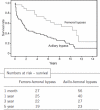Extra-anatomical bypass grafting--a single surgeon's experience
- PMID: 20522294
- PMCID: PMC3182793
- DOI: 10.1308/003588410X12664192076890
Extra-anatomical bypass grafting--a single surgeon's experience
Abstract
Introduction: Extra-anatomical bypass grafting is a recognised method of lower limb re-vascularisation in high-risk patients who cannot tolerate aortic cross clamping, or in those with a hostile abdomen. We present a single surgeon series of such procedures and determine relevant outcomes.
Patients and methods: A retrospective review was performed on a prospectively maintained database of patients undergoing femoro-femoral or axillo-femoral bypass surgery between 1986 and 2004.
Results: Patency rates for femoral (n = 28; 32%) versus axillary (n = 59; 68%) bypass procedures at 1 month, 1, 3 and 5 years were (92% vs 93%), (69% vs 85%), (60% vs 72%) and (55% vs 67%), respectively. Patient survival rates for the corresponding procedures and time intervals were (96% vs 90%), (96% vs 67%), (85% vs 45%) and (73% vs 38%) and revealed a significantly lower survival rate in those undergoing axillary procedures (P = 0.002). Limb salvage rates were calculated at (100% vs 91%), (96% vs 84%), (96% vs 81%) and (92% vs 81%) with no statistically significant difference found between the two groups (P = 0.124). Two-thirds of the patients who required major amputation died within 12 months of surgery.
Conclusions: Acceptable 30-day morbidity, long-term primary patency and survival rates are obtainable in patients suitable for extra-anatomical bypass surgery despite having significant co-morbidities. We have shown 5-year patency rates in those that survive axillary procedures to be as good as those undergoing femoral procedures. Furthermore, surviving patients who evade amputation within a year have an excellent chance of long-term limb salvage.
Figures
References
-
- Blaisdell FW, Hall AD. Axillary-femoral artery bypass in lower extremity ischaemia. Surgery. 1963;54:563–8. - PubMed
-
- Louw JH. Splenic to femoral and axillary to femoral bypass grafts in diffuse artherosclerotic occlusive disease. Lancet. 1963;1:1401–2.
-
- Whatling PJ, Gibson M, Torrie EP, Magee TR, Galland RB. Iliac occlusions: stenting or crossover grafting? An examination of patency and cost. Eur J Vasc Endovasc Surg. 2000;20:36–40. - PubMed
-
- Upchurch GR, Jr, Dimmick JB, Wainess RM, Eliason JL, Henke PK, et al. Diffusion of new technology in health care: the case of aorto-iliac occlusive disease. Surgery. 2004;136:812–8. - PubMed
MeSH terms
LinkOut - more resources
Full Text Sources


